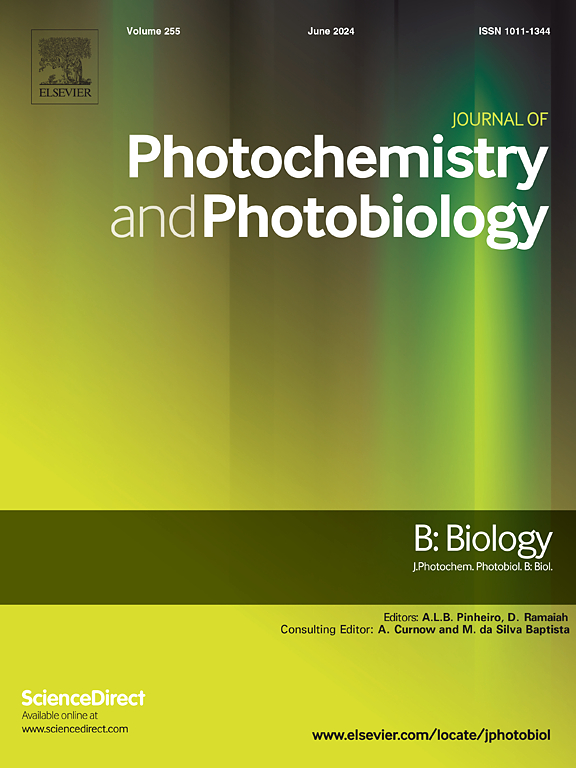Fungal derived dye as potential photosensitizer for antimicrobial photodynamic therapy
IF 3.9
2区 生物学
Q2 BIOCHEMISTRY & MOLECULAR BIOLOGY
Journal of photochemistry and photobiology. B, Biology
Pub Date : 2025-01-29
DOI:10.1016/j.jphotobiol.2025.113116
引用次数: 0
Abstract
Photodynamic therapy (PDT) combines light with a photosensitizing agent to target and destroy abnormal cells or pathogens, offering a non-invasive and precise approach. Applying microbial dyes in PDT presents a great opportunity because these compounds may absorb specific wavelengths of light, generating reactive oxygen species (ROS) that induce oxidative stress, leading to cell or microbial death. This study evaluated the extract of Talaromyces amestolkiae containing azaphilone red dyes obtained from cultivation process as photosensitizer (PS) in antimicrobial photodynamic therapy (aPDT). Initially the crude extract was obtained in incubator shaker varying the culture media composition. Following, the crude extract containing the red dyes exhibited non-toxicity in dark conditions across all concentrations tested. PDT experiments with different amounts of the crude extract at a light dose of 80 J.cm-2 and upon irradiation at 460 nm was studied. A complete reduction of Escherichia coli and approximately 2 log10 reductions of Staphylococcus aureus, Cutibacterium acnes and Enterococcus faecalis was achieved using 25 % (v.v-1) of the crude extract while 50 % (v.v-1) of the crude extract led to a complete reduction of both E. coli and S. aureus, and around 5 log10 reductions of C. acnes and E. faecalis. Importantly, minimal photodegradation of the PS occurred during irradiation across all concentrations studied. These findings highlight the potential of T. amestolkiae-derived red dyes extract for use in aPDT, demonstrating non-toxicity in the absence of light, good aqueous solubility, high photostability, and strong microbial reduction capabilities under specific light conditions.

真菌衍生染料作为抗菌光动力治疗的潜在光敏剂
光动力疗法(PDT)结合光与光敏剂来靶向和破坏异常细胞或病原体,提供了一种非侵入性和精确的方法。在PDT中应用微生物染料提供了一个很好的机会,因为这些化合物可以吸收特定波长的光,产生活性氧(ROS),诱导氧化应激,导致细胞或微生物死亡。本研究评价了从培养过程中获得的含氮蚜酮红色染料的Talaromyces amestolkiae提取物作为光敏剂(PS)在抗菌光动力治疗(aPDT)中的应用。最初,粗提物是在培养摇床中改变培养基组成得到的。随后,含有红色染料的粗提取物在所有测试浓度的黑暗条件下都表现出无毒。研究了不同剂量的粗提物在80 J.cm-2的光剂量和460 nm辐照下的PDT实验。使用25% (v - v-1)的粗提取物,大肠杆菌完全减少,金黄色葡萄球菌、痤疮角质杆菌和粪肠球菌减少约2 log10,而50% (v - v-1)的粗提取物导致大肠杆菌和金黄色葡萄球菌完全减少,痤疮c和粪肠球菌减少约5 log10。重要的是,在所有研究浓度的辐照过程中,PS发生了最小的光降解。这些发现突出了amestolkie衍生的红色染料提取物在aPDT中应用的潜力,显示出在无光条件下无毒,良好的水溶性,高光稳定性以及在特定光条件下很强的微生物还原能力。
本文章由计算机程序翻译,如有差异,请以英文原文为准。
求助全文
约1分钟内获得全文
求助全文
来源期刊
CiteScore
12.10
自引率
1.90%
发文量
161
审稿时长
37 days
期刊介绍:
The Journal of Photochemistry and Photobiology B: Biology provides a forum for the publication of papers relating to the various aspects of photobiology, as well as a means for communication in this multidisciplinary field.
The scope includes:
- Bioluminescence
- Chronobiology
- DNA repair
- Environmental photobiology
- Nanotechnology in photobiology
- Photocarcinogenesis
- Photochemistry of biomolecules
- Photodynamic therapy
- Photomedicine
- Photomorphogenesis
- Photomovement
- Photoreception
- Photosensitization
- Photosynthesis
- Phototechnology
- Spectroscopy of biological systems
- UV and visible radiation effects and vision.

 求助内容:
求助内容: 应助结果提醒方式:
应助结果提醒方式:


